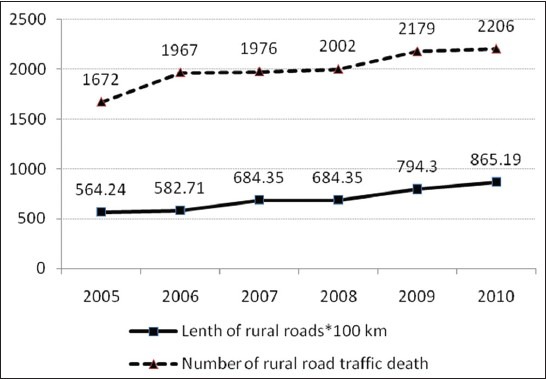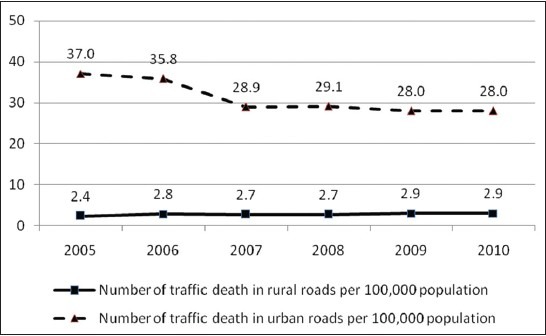Abstract
Background:
The 5th Iran National Development Plan, 2011-2015, has emphasized on expansion of rural asphalt roads. This article aims to illustrate the trend of deaths caused by rural road traffic crashes (RTCs) and its association with length of the rural roads in Iran.
Methods:
We carried out a retrospective analysis on secondary data for the period from 2005 to 2010. The Iranian Forensic Medicine Organization, High Commission for Road Safety and Iran's Statistical Center were the sources for the number of RTC death, length of the road and population data, respectively.
Results:
Number of RTC deaths in rural roads increased from 1,672 in 2005 to 2,206 in 2010. This was associated with expansion of the rural asphalt roads (P = 0.04). The construction of urban asphalt roads was also on an increasing trend, but the number of traffic deaths in these roads decreased from 26,083 in 2005 to 21,043 in 2010. Adjusted for 100,000 populations, the number of traffic deaths in urban roads showed a decrease from 37.0 to 28.0, while this number increased from 2.4 to 2.9 in rural roads during the study period.
Conclusions:
Although expansion of rural roads would contribute to economic development in rural areas, it exposes people to risk of severe RTCs if effective preventive actions are not taken. To prevent this threat, the Iranian policy makers need to take the followings into consideration: Public awareness, improving the safety of roads and vehicles, law enforcement, increasing coverage of police and Emergency Medical Services.
Keywords: Death, injury, Iran, road traffic crash, rural road
INTRODUCTION
Road traffic crash (RTC) is the main cause of non-intentional injuries and the second cause of deaths after ischemic heart diseases in Iran.[1] It accounts for more than 10% of total mortalities[2] and about 23,000 deaths, in average, per year during the last decade.[3] This is approximately equal to the number of deaths caused by the 2003 Bam earthquake, one of the worst natural disasters of recent decades.[4] These facts have made the RTC as a man-made disaster and real public health concern in Iran.
In line with the fourth I.R. Iran's National Development Plan (NDP), the fifth NDP for 2011-2015[5] has emphasized on development of rural infrastructures, including rural asphalt roads. Although this development has led to more traffic in rural roads, no significant improvement is observed in safe driving behavior and construction of roads in rural areas. In addition, compared with urban areas, rural people use older cars with less safety standards.[6] The monitoring by traffic police and coverage of Emergency Medical Services (EMS) are also lower in rural roads than main roads.[2]
This article aims to provide the Iranian policy makers with information on the burden of deaths that are caused by rural RTCs and demonstrates its association with expansion of the rural roads.
METHODS
We applied a retrospective analysis of secondary data to demonstrate the association of rural RTCs deaths with expansion of the rural roads in Iran. Our study covered the period from 2005 to 2010. The variables of interest included length of road (rural and urban), number of death (caused by rural and urban RTCs) and number of population. The sources that we used for data collection were the Iran's High Commission of Road Safety (HCRS) for length of road (km), the Iran's Forensic Medicine Organization (FMO) for the number of RTCs death and the Iran's Statistical Center for population data. International Classification of Diseases-10 is the basis for coding the causes of death by FMO.
For the purpose of analysis, we illustrated the trends of length of rural road from 2005 to 2010 and their corresponding mortality. Rates of traffic death in rural and urban roads were also estimated per 100,000 populations. χ2 for trend was the test of significance and P < 0.05 was considered as statistically significant. SPSS statistical software for windows (Version 11.0, Chicago, IL) was used for statistical analysis.
RESULTS
The number of RTC deaths in rural roads increased from 1,672 in 2005 to 2,206 in 2010. This was parallel to construction of the rural asphalt roads that was increased from 56,424 to 86,519 km during the same period [Figure 1]. The trend analysis showed a positive association between these two variables (χ2 for trend = 3.93, df = 1, P = 0.04).
Figure 1.

Length of rural asphalt roads and number of deaths caused by rural road traffic crashes, Iran, 2005-2010
The expansion of urban asphalt roads was also on an increasing trend from 71,711 to 77,964 km, but the number of traffic deaths in these roads decreased from 26,083 in 2005 to 21,043 in 2010.
From 2005 to 2010, adjusted for 100,000 populations, the number of traffic deaths in urban roads decreased from 37.0 to 28.0, while this number increased from 2.4 to 2.9 in rural roads [Figure 2].
Figure 2.

Trends of traffic death in rural and urban roads, Iran, 2005-2010
DISCUSSION
Our study showed an increasing trend of the RTC deaths in Iran's rural roads and its positive association with expansion of the rural roads. This is while, at the same period, the rate of traffic death in urban roads was on a decreasing trend.
Therefore, expansion of the road network is one of the most important prerequisites for development of economics and infrastructures in rural areas, the policy makers should take preventive measures in rural roads to improve the safe driving condition. In this line, the highest-level of political commitment undoubtedly enhance the fight against RTC deaths.[7] Iran's Ministry of Road and Urban Construction is the lead agency for the HCRS. Traffic police, EMS and car factories are the main stakeholders of this national coordination body. To reduce the rate of deadly traffic crashes in rural roads, taking the coordinated measures by the HCRs' members is necessary. In this line, the HCRS may also rely on the successful experience in decreasing the rate of urban RTC deaths.
According to available literature, the risk factors of deadly RTCs in rural roads of Iran are unsafe roads, excessive speed, risky driving caused by inadequate knowledge and inappropriate risk perception, no use of seat belt and using of old cars with low safety equipments.[2] Crash with livestock that freely move across the roads is another factor.[6] Effectiveness of the enforcement measures for control of RTCs in Iran is rated six out of 10, according to the World Health Organization.[8] This is expected to be even lower in rural roads as they are less controlled by traffic police compared with freeways, highways and main roads.
Timely and quality provision of medical care is essential for saving lives in a RTC. In 2010, the national Emergency Medical Service was only able to cover 15% of minor roads, including rural areas. According to National EMS, in addition to the current 1,028 EMS stations, 5,000 more stations are needed for effective coverage of roads all over the country.[9] This requires a considerable financial investment.
Rural RTC is a concern not only in developing countries like Iran, but also it accounts for the considerable number of death in developed countries.[10,11,12] For instances, in Germany, Britain and the US, about two third of all RTC related fatalities occur on rural roads, which score badly when compared to the high quality motorway network in those countries. All these have said, there are evidences that fortunately show how the preventive measures can be effective in reducing rural RTCs. For example, in Germany, reinforcement of speed limits and development of additional passing lanes were found effective.[11]
CONCLUSIONS
The expansion of rural asphalt roads exposes the people of rural areas with risk of severe RTC if effective preventive measures are not taken. To prevent from this threat, the Iranian policy makers need to take the followings into consideration: Public awareness, improving the safety of roads and vehicles, law enforcement, increasing coverage of police and EMS.
Footnotes
Source of Support: Nil
Conflict of Interest: None declared.
REFERENCES
- 1.Ardalan A, Masoomi GR, Goya MM, Sarvar MR, Haddadi M, Miadfar J, et al. Road traffic injuries: A challenge for Iran's health system. Iran J Public Health. 2009;38(Suppl):99–101. [Google Scholar]
- 2.Naghavi M, Shahraz S, Bhalla K, Jafari N, Pourmalek F, Bartels D, et al. Adverse health outcomes of road traffic injuries in Iran after rapid motorization. Arch Iran Med. 2009;12:284–94. [PubMed] [Google Scholar]
- 3.Emergency Medical Services Report, Iranian Disaster and Emergency Management Center; Ministry of Health and Medical Education, Tehran, Iran. 2012. (In Farsi)
- 4.Naghavi M, Abolhassani F, Pourmalek F, Lakeh M, Jafari N, Vaseghi S, et al. The burden of disease and injury in Iran 2003. Popul Health Metr. 2009;7:9. doi: 10.1186/1478-7954-7-9. [DOI] [PMC free article] [PubMed] [Google Scholar]
- 5.Parliament of Islamic Republic of Iran. Fifth national development plan. [Last accessed on 2011 Dec 10]. Available from: http://www.parliran.ir/index.aspx?siteid=1 & siteid=1 & pageid=3362 .
- 6.Kashani AT, Shariat-Mohaymany A, Ranjbari A. Analysis of factors associated with traffic injury severity on rural roads in Iran. J Inj Violence Res. 2012;4:36–41. doi: 10.5249/jivr.v4i1.67. [DOI] [PMC free article] [PubMed] [Google Scholar]
- 7.Mokdad AH. The United States of America and the Islamic Republic of Iran: The path to preventing traffic injuries? Popul Health Metr. 2010;8:4. doi: 10.1186/1478-7954-8-4. [DOI] [PMC free article] [PubMed] [Google Scholar]
- 8.World Health Organization. Global Status Report on Road Safety: Time for Action. Geneva: World Health Organization; 2009. [Google Scholar]
- 9.Ministry of Health and Medical Education. Tehran, Iran: 2010. Emergency Medical Services Report, Iranian Disaster and Emergency Management Center. (In Farsi) [Google Scholar]
- 10.National Highway Traffic Safety Administration. Traffic crashes take their toll on America's rural roads: The need to establish rural safety belt programs. 2006. [Last accessed on 2011 Dec 10]. Available from: http://www.nhtsa.gov/people/injury/airbags/RuralCrashes/1125.Rural%20Crashes.pdf .
- 11.Weber R, Jährig TH. 4th International Symposium on Highway Geometric Design. Valencia, Spain: Pubished by Transportation Research Board; Polytechnic University of Valencia; 2010. [Last accessed on 2011 Dec 10]. “AOSI” improving road safety on rural roads in Germany. Available from: http://www.pubsindex.trb.org/view.aspx?id=1100509 . [Google Scholar]
- 12.Castle J, Lynam D, Martin J, Lawson SD, Klassen N. Star rating roads for safety, UK trial 2006-7. 2007. [Last accessed on 2011 Dec 10]. Available from: http://www.eurorap.org/library/pdfs/20071130_UK_RPS_report.pdf .


